The Violent, Royal Story of How Tartan Became Your Favorite Plaid
In Depth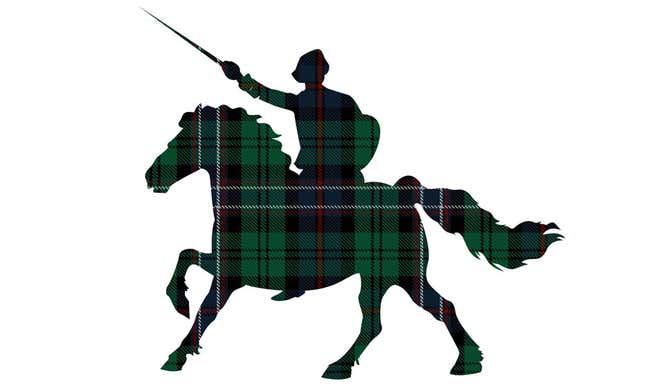

Tartan in modern fashion appears everywhere from school uniforms to McQueen runways, but the road to this ubiquity starts many centuries ago, with 15th-century Scottish women weaving this particular patterned fabric at home. It wasn’t until the early 19th century that tartan would start weaving its way into American women’s fashion, from shawls and bonnet trims all the way to more recent menswear-inspired suits (think Cher’s in Clueless). And today, tartan occupies a relatively unique position: completely distinctive, full of aesthetic signal, but somehow flexible enough to fit any occasion.
To understand how we got here, let’s start with the definition.
Tartan is defined by the Scottish Register of Tartans as “a simple two-colour check to which the designer adds over-checks, bands and stripes in contrasting colours. These should be arranged to result in a balanced and harmonious pattern. A tartan pattern is a geometric design, made up of blocks of solid colour which join on the diagonal, radiating across the fabric like spokes, and with each block of colour surrounded by blocks of mixed colours. The blocks form a pattern, reflected or repeated many times across both the warp and weft of the cloth.”
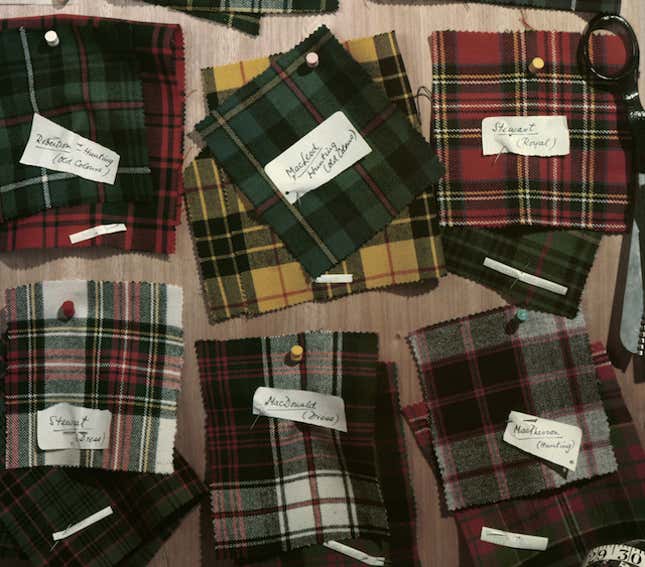
It’s a very specific definition. But essentially, tartan is just a system of interlocking stripes woven regularly into the fabric in both the vertical and horizontal sets of threads. The exact size and color of each stripe is called the sett. It’s that regular, geometric quality to the sett that’s particularly important in separating tartan from other plaids.
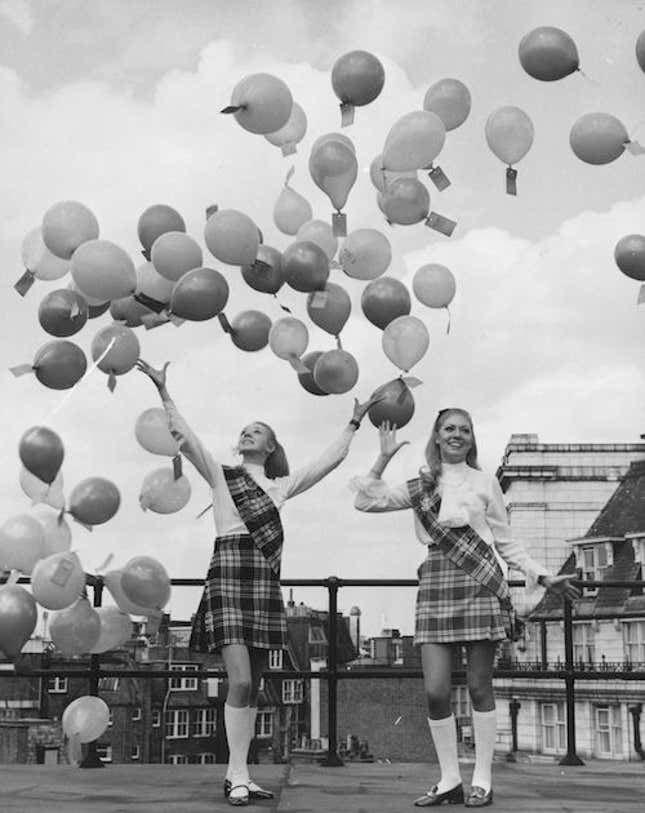
While all tartans are plaids, not all plaids are tartans. (Other types include madras, gingham, houndstooth.) In the Scottish Highlands, the term “plaid” originally referred not to a type of pattern but to a large piece of woven fabric (like a blanket) that could be worn in several ways, by both men and women. Its most famous use, as a “belted plaid,” evolved into what we now know as a kilt. Plaids were usually but not always actually plaid-patterned and were sometimes striped or solid instead.
At some point between the adoption of the plaid (pictorial evidence shows them as common garments by the 14th century) and the 19th century, “plaid” came to mean not the garment but the pattern itself. Fabric was woven locally, often at home: so, the change in terminology was slow, and “plaid” meaning pattern and “plaid” meaning garment were used interchangeably well into the 18th century. By 1600, “tartan” was being used in reference to its distinct pattern of colored, cross-directional stripes.
(It’s worth noting that plaid fabrics have existed in other places besides the UK for a very long time: as far back as 3000 BC, according to the Scottish Tartans Museum of North Carolina. But the particular political frenzy surrounding tartan in the 18th and 19th centuries is a direct contributor to the pattern’s ubiquitous use today, particularly in America.)
After the Act of Union in 1707, England and Scotland became united, and tartan became a national symbol of dislike for the merger. The pattern’s nationalistic associations began to be enshrined by romanticized descriptions of men wearing plaids (the garment), from Gaelic praise poetry about “luchd nam braecanan fheilidh” (the men of the pleated tartans) to the writing of Walter Scott. In paintings, plaid-wearing Highlanders were often depicted on a cliff or rocky outcropping, the wind blowing the pleats of the belted plaid or a woman’s shawl astray. In real life, the home-woven fabrics would have shown much more variation, but in these images the tartans are often simple, with only a couple of colors: often blue/green or red/black.
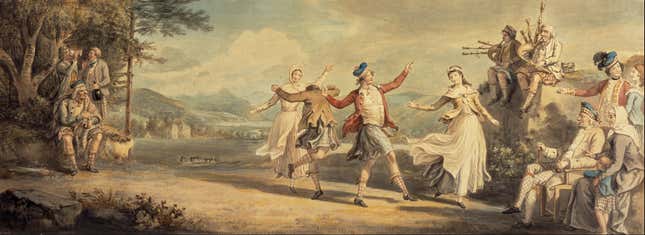
During the Jacobite Rising of 1745, tartan became explicitly linked to political causes. That year, Prince Charles Stewart, challenger for the British throne, adopted traditional Highland dress as his army’s uniform. (Charles himself did not wear a belted plaid until after his defeat, but did wear tartan.) In possibly the most famous portrait of “Bonny Prince Charlie,” he is wearing a fashionable suit of red/black tartan with extensive gold trim. The tartans on illustrations of his regiment also often include red, but are more varied; they were probably homemade, as it’s difficult to produce uniform materials for a rebellion.
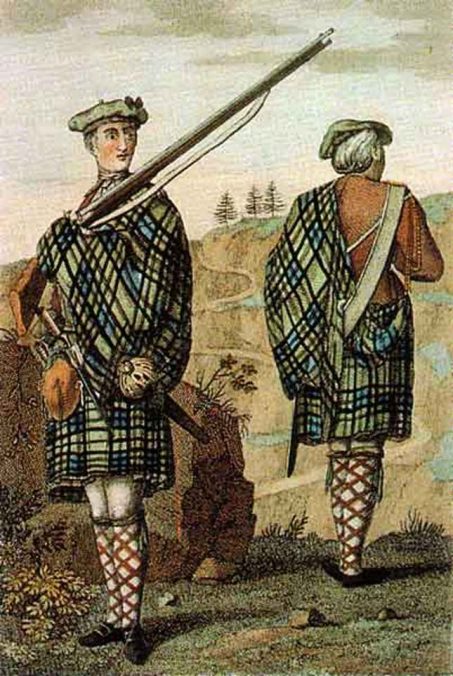
The Jacobites were defeated by the British army and Bonny Prince Charlie was exiled to France with a bounty on his head. In the political aftermath, tartan still carried the flavor of rebellion: this led to the Dress Act of 1746, which outlawed the wearing of Highland dress and tartan, as pictured at right. Tartan did not disappear completely (notably, its wearing was not outlawed as part of military uniforms, and naturally, its use there thrived), but the pattern slipped from public life for some time.
Then, in 1778, the Highland Society of London was founded to preserve the traditions the Dress Act had stifled. They were instrumental in the Act’s eventual reprieve in 1782, and were the first group to collect tartan patterns specifically from the clans, which they kept in The Collection of Certified Tartans—the beginnings of the modern governmental board. After the repeal of the Dress Act, tartan became widely popular again: the 1780s marked the rise of the first commercial tartan weavers and the start of mass exodus of Scottish Highlanders during the Highland Clearances. All of this led to the mass production and dissemination of the highland pattern, as far and wide as America.
Which returns us to the earlier question: just what is so special about tartan?
At first it was patriotism. But later, one might presume, the fact that it was forbidden gave tartan an extra appeal. Because the only people allowed to wear tartan were soldiers, the government pattern was standardized by 1812 and thus became easy to spread after the Dress Act was reprieved. This sett, described in Hugh Cheape’s Tartan as a “dark tartan of green, blue, and black in which distinguishing lines of red, white and yellow were added for different regiments,” may sound familiar: several popular tartans today (Gordon Highlanders, Blackwatch) all date as military tartans from the 18th and early 19th century, and highlight these colors.

And then, in the 1820s, the public began to romanticize the Scottish Highlands again, an obsession that culminated in Queen Victoria’s mid-19th century enchantment with Balmoral Castle. (Her daughters, Princesses Helena and Louise, are pictured in tartan to the left.) The concept of clan tartans started to become quite popular, aided by technological advances that allowed for the easy mass production of bright, fabulous woven textiles. Mechanically-woven plaids started appearing on everything from dresses and jackets to undergarments with increasing frequency, peaking in the 1860s and again in the very early 20th century with the rise of the “modern woman,” menswear-inspired ensembles, and female sports attire.
Other patterns have come and gone in America (paisley prints, images of pineapples) but tartan—this romantic yet vivid plaid—has been consistently in fashion for over a century, and it remains popular today. There’s just something about it: a standardized pattern with infinite variations and meanings. The 1819 Key Pattern Book of commercial tartan mill Wilsons of Bannockburn lists 200-250 different tartans in production just in the first two decades of the 19th century, and we couldn’t begin to count all the different plaids you could wear today.

Today, specific setts are registered with the Scottish Register of Tartans, the governmental body responsible for the registration, promotion, and preservation of tartans as a historically and culturally significant part of Scottish heritage. Browsing the collection, you might be surprised by some of the entries: Massachusetts has an official tartan called the Bay State tartan (“blue for the Atlantic Ocean, reservoirs, rivers and ponds; green for the Boston Hills, Worcester Hills and the Berkshire Mountains; tan for the beach line from the North to South Shore, Cape and Island and Buzzards Bay, plus red for the apple and cranberry harvests”); the Afghanistan Memorial tartan commemorates the lives lost in violence there since 2001 (“The light and dark browns signify the parched and arid countryside of Afghanistan; the blue is representative of the impressive mountain ranges with the white of the snow bound peaks. The blood red is the tragedy of the human cost on all sides.”).
Just like it was in its 18th-century heyday, tartan today is both an element of fashion and a symbol of something greater. It is still worn by many military units worldwide: some U.S. units with British connections have their own official tartans, even. It is still commonly associated with private school uniforms; it’s also an integral part of punk and other alternative fashions. Just as tartan was worn by both rebels and regiments in the 18th century, its use as battle garb on both sides of the divide still defines it in the 21st.
L. R. Stern spends her weekdays working towards the scientific future, and her weekends in the reimagined past. Her particular interests include the evolution of amateur photography, the use of plaid in 19th century fashion, and badass historical women. When she’s not causing trouble in costume, L.R. blogs about her adventures (and the research behind them) at plaidpetticoats.blogspot.com.
Illustration by Tara Jacoby
Additional sources:
• Tartans: Pleasures and Treasures, Christian Hesketh (1961)
• Scottish Tartans Museum of North Carolina
• Costume of Scotland, by John Dunbar (1981)
Images: Getty, Getty, David Allan, Wikimedia Commons, Getty, Getty